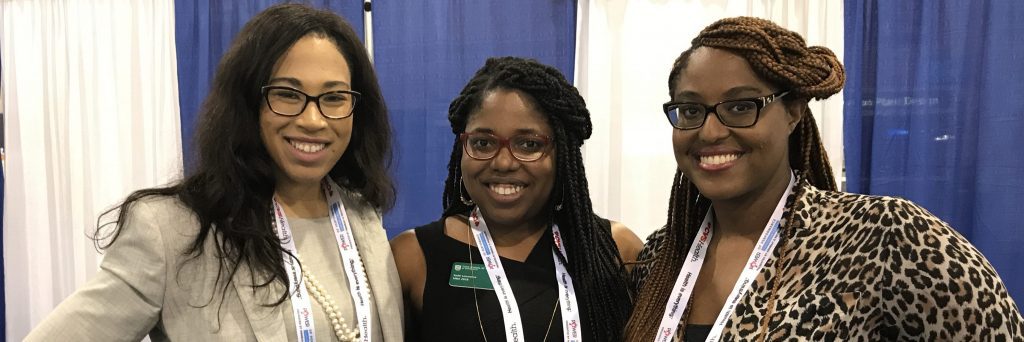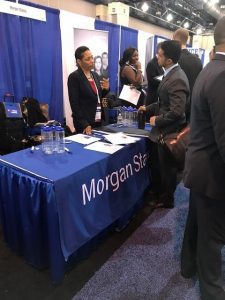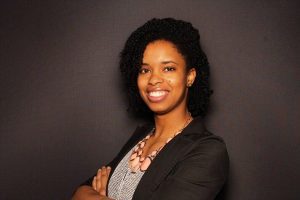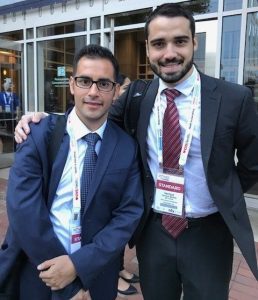The Top 5 Reasons Diversity MBA Conferences Should Be on Your Recruiting Calendar

Pictured above: Tuck second-year MBA students Bianca Goins, Sadé Lawrence, and Jodine Gordon.
More than 10,000 MBA students, business school representatives, recruiters, and business executives filled the Pennsylvania Convention Center in Philadelphia late last month for one of the largest career conferences serving minority professionals. The conference has been around since 1970, but for the first time this year the National Black MBA Association (NBMBAA) and Prospanica, the association of Hispanic professionals, joined forces to present it. The result was an incredible opportunity for attendees to network with companies and each other, take advantage of career development programming, and interview for and secure job offers from hundreds of companies spanning multiple industries.
Cornell’s S.C. Johnson Graduate School of Management had a group of approximately 55 students attend, a mix of first-year and second-year students, according to Cynthia Saunders-Cheatham, Executive Director of Johnson’s Career Management Center.
“It was double what we have had in recent years, and perhaps the largest attendance we ever had for an MBA diversity conference,” she said. “Having a joint NBMBAA/Prospanica conference, in addition to the Philadelphia location that was driving distance away [from Ithaca, NY, where Johnson is located], helped to drive attendance.” The connections that students made while there have already resulted in multiple job offers, she added.
While securing a job or internship is a primary reason many MBA students choose to attend the National Black/Prospanica conference and others like it, that’s just one of many potential benefits events like this offer. Given that this most recent conference was right here in our hometown of Philadelphia, we went to check things out for ourselves. Through conversations with attendees, school representatives, and recruiters, we’ve compiled the following list of reasons why this year’s crop of applicants should be sure to add diversity MBA conferences to their recruiting calendar next summer and fall.
1. Unparalleled Recruiter Access—Including Many That Don’t Come to Campus
The Career Expo, which took place on the last two days of the five-day National Black/Prospanica conference, filled a cavernous hall in the Convention Center and included booths from close to 300 companies spanning dozens of industries. Among them were coveted post-MBA tech employers like Google and Amazon, consulting industry leaders including Bain & Company and Accenture, and financial services firms such as BlackRock, Bank of America, and Morgan Stanley. There was a continuous gaggle at the Google booth, and one of its MBA internship recruiters, Tanya Choudhury, had to resort to wearing a sign by the second day explaining that she’d lost her voice.
Big pharma and healthcare were also well represented, with booths attended by recruiting representatives from drug maker AstraZeneca to medical products and equipment company Zimmer Biomet and many in between. Leading consumer packaged goods (CPG) firms including PepsiCo, General Mills, and Proctor & Gamble were also there, as were oil and gas giants like BP, Chevron, and Exxon.

Morgan Stanley was one of almost 300 exibitors in the conference’s packed Career Expo.
But there were also plenty of organizations that are perhaps less top of mind as potential MBA recruiters—the Central Intelligence Agency, the U.S. Department of State, Teach for America, and USAID, for example—who were just as eager to share how highly they value the MBA skillset. Dozens of leading business schools also had booths, largely to provide support and serve as gathering places for students who were attending, but also with an eye out for promising diverse talent. For example, Roberto Martinez, a Senior Talent Acquisition Consultant for Dartmouth College—home to the Tuck School of Business—was eagerly distributing glossy handouts touting the school’s varied career opportunities, commitment to diverse hiring practices, and excellent benefits. “We’re here not only to support students but also to hire more diverse staff to campus,” he said.
For Tuck second-year MBA student Bianca Goins, the breadth of companies at the expo was a big part of the draw. “I wanted a diverse group of companies to look at in a single spot,” she said. “There are so many companies here, and as second-year you can really come and pick and choose the experiences you want to have.”
Tiffany Anderson, a second-year student at Emory’s Goizueta Business School, was also impressed by the sheer number of companies present. A self-proclaimed conference veteran, she also attended National Black last year, as well as conferences presented by the Forté Foundation, the Consortium for Graduate Study in Management, Management Leadership for Tomorrow, and JumpStart. “Out of all the diversity conferences, I would certainly say this is the flagship,” she said. “Wow! There are A LOT of companies here,” she recalled thinking to herself as she walked in. More so than last year, before National Black and Prospanica teamed up, she added.
“I have seen the most people—students from many different schools and recruiters from many different functional areas of interest,” she continued. “It seems to be the most diverse in terms of attendees, degree of programming, and companies in attendance. For the majority of people, this is going to be one of the best to attend.” Anderson estimates that there were probably 30 or so Goizueta students there, a mix of first- and second-years.
2. Multiple Touch Points and Opportunities for Face Time
For some students, certainly, the primary purpose in attending the conference is to land a job. Second-year IU Kelley School of Business MBA student Henrique Barbosa, a native of Brazil pursuing travel hospitality, had a simple answer when asked why he was there: “To get a job!” He acknowledged that most of the firms he was interested in only conduct first-round interviews at the conference followed by second-round interviews on site, which lessened the likelihood of his leaving with an offer in hand. “But it would be great if it happened,” he said.
But several other students were less interested in job or internship offers—or even in early round interviews. For Jodine Gordon (Tuck ’18), the biggest factor in her decision to attend was hearing success stories from Tuck grads whose higher-level touch points with conference recruiters later helped them secure offers. “I have a couple companies on my list, but really I just want to meet as many people as possible so they can get to know me and I can get face time,” she said.
Sadé Lawrence, also a second-year student at Tuck, was likewise attracted by the opportunity to get in front of recruiters in person. “For a lot of opportunities you might be interested in, you start online at a website, applying through data base,” she said. “But coming here they now have a face with your name, and there are all kinds of organic connections that can happen,” she added. “It’s kind of amazing that you are able to build connections with people even at such a big conference, but you are. You make contacts and get lots of face time—so much more so than you can blindly through a website,” she continued. “What I have heard more of is people have an interaction with a recruiter here that leads to an interview later—here is more about entering the pipeline.”
Tuck’s Goins has taken the opportunity to network with recruiters who don’t make it to Tuck’s campus, but also those who do. “With every interaction, you are getting a more nuanced understanding of the company and can take that information and use it in subsequent interactions.”
3. Valuable Chances to Network with Peers
Goizueta’s Anderson interned in operations at Google over the summer—an opportunity she got through another diversity conference—and has been offered a full-time position on the tech giant’s Mountain View campus after she graduates. Despite having that full-time offer in hand, attending the conference still made lots of sense.
Kelley School second-year student Luis Vilchez Kupres, a native of Peru, also converted his summer internship—in supply chain operations at Cummins—into a full-time offer. So his reasons for attending the conference were not to get a job. ”I am here to support fellow Kelley first- and second-years and network a little more,” he said. He also gets to reconvene with students from other schools he met at last year’s Prospanica conference. “Often, you connect with somebody and they will help you connect with someone else,” he said. “Networking definitely helps—even among other MBA students.”

Tiffany Anderson, Goizueta MBA ’18, a diversity MBA conference veteran
For the Google-bound Anderson, the value of peer networking can’t be stressed enough. Being able to connect with students from other schools is the part she finds most enjoyable—but it’s also strategic. “When candidates are selecting a school they like to look at the size of the network they are going to get—and that’s great,” she said. “But the way I see it, I don’t have to be at Stanford or Wharton because I have friends at Stanford and Wharton. So in a way that’s kind of my network, too.”
“You have that domino effect,” she continued. If she’s trying to connect with someone at a company where she doesn’t have a contact or her classmates don’t have contacts, she can reach out to a friend at another school to see if there’s someone in their network. “Some might say, ‘Well, they’re a peer, they’re not an employer, they’re not going to get me a job.’ But there is so much more benefit to expanding your network. I don’t think everyone understands that.”
Of course, peer networking can be a two-way street. “My motivation to expand my network comes from wanting to help others as well,” Anderson said. “When you are part of these diversity networks, one of the great things is you are going to have a friend who says, ‘Do you know someone who can help me with this?’ And I can say, ‘Well, I met someone at a conference who does that very thing and I’m happy to put y’all in touch.’”
4. A Better Way to Gauge Company Culture, True Commitment to Diversity
Another recurring theme we encountered when asking students about what they valued most about the conference was getting an up-close, real-time glimpse of companies’ cultures. “You get to observe the way the people representing a company interact with one another and other candidates, and that can be very telling about the culture,” said Tuck’s Gordon.
Who a company decides to send to the conference also sends a signal. “There is a difference when a company sends actual diverse talent—and that might mean sending someone in addition to the actual recruiter,” said her classmate Goins. “It think it says something to see actual diverse employees there who want to bring diverse talent back to the company.”
While representation is important, authenticity is key. “When I have a conversation with someone from a company and I ask about what diversity initiatives the company has or what opportunities there are for people like me, I feel like you hear it in the answer if it is genuine or if it just sounds like it’s cookie cutter, from a script,” added Anderson. Not every company will have amazing success stories to point to, she continued. “Not everything is going to be rosy—some companies are working on it, and that’s okay,” she said. But for companies that say they want to have more diversity, she wants to see evidence of their commitment. “When I follow up and ask what they’re doing, I want a genuine answer, not just, ‘I don’t know.’”
For Kelley students Barbosa and Vilchez Kupres, getting to meet with company recruiters at the conference also sheds light on how open those companies are to hiring international students. “Yes, especially for us internationals, we need to understand if they are willing to sponsor,” said Vilchez Kupres. “It’s one thing to hire Latins that were born in the U.S., it’s another thing to see that companies really want internationals who have experience working in other countries.”
5. Inspiration
Last but certainly not least, students come to the NBMBAA/Prospanica conference to hear from trailblazing minority executives who have climbed the ranks to the highest levels in a business landscape that, despite progress, is still dominated by white men.
“One of our students is very connected with NBMBAA, and her primary purpose in attending the conference was to get inspiration,” said Melissa Uyesygi, Associate Director of Diversity and Inclusion at the University of Washington Foster School of Business. Foster School representatives and students attend the conference each year, she said. This year, though, the cross-continental location and associated cost of attending, coupled with the fact that the conference fell during th

Kelley second-year MBA students Luis Vilchez Kupres and Henrique Barbosa
e very first week of classes at Foster, kept the numbers lower than usual. Still, for the student seeking inspiration as well as a classmate hoping to connect with financial services firms who don’t recruit on Foster’s Seattle campus, the conference seemed worth the trip.
And for those seeking inspiration, it was abundant. A CEO luncheon panel discussion moderated by Carla Harris, Morgan Stanley vice chairman of wealth management, addressed the necessity of “next-level leadership” to drive results. The panelists—Marriot International CEO Arne Sorenson, GE Lighting President and CEO Bill Lacey, and Adtalem Global Education President and CEO Lisa Wardell—touched on everything from how they have faced their biggest challenges to the importance of servant leadership, with each offering up advice to the would-be CEOs in the audience on how to propel their leadership careers. “Just say ‘yes,’” counseled Sorenson. “Start living it now,” said Wardell. “It can’t be a job—it has to be a passion,” chimed in Lacey.
Other headliners offering words of wisdom and hard-earned tips for success included award-winning journalist and TV personality Tamron Hall and Washington Post sports columnist Kevin Blackistone, among many others.
As if the above weren’t reason enough to attend, the conference also included breakout sessions and workshops on topics ranging from “How to Make Your Side Hustle Your Main Hustle” and “Leadership in a Difficult Climate” to the “Business Side of Sports” and “Mastering the Career Pivot.” Case competitions, a pitch competition, and an array of social and networking events hosted by individual companies rounded out the conference’s five packed days of programming.
As Johnson’s Saunders-Cheatham pointed out, the conference also serves to jumpstart the career search process for many students. “It shocks them into realizing what it takes to be ready for the career search,” she said.
Next year’s conference will take place September 25-29, 2018, in Detroit, Michigan.
